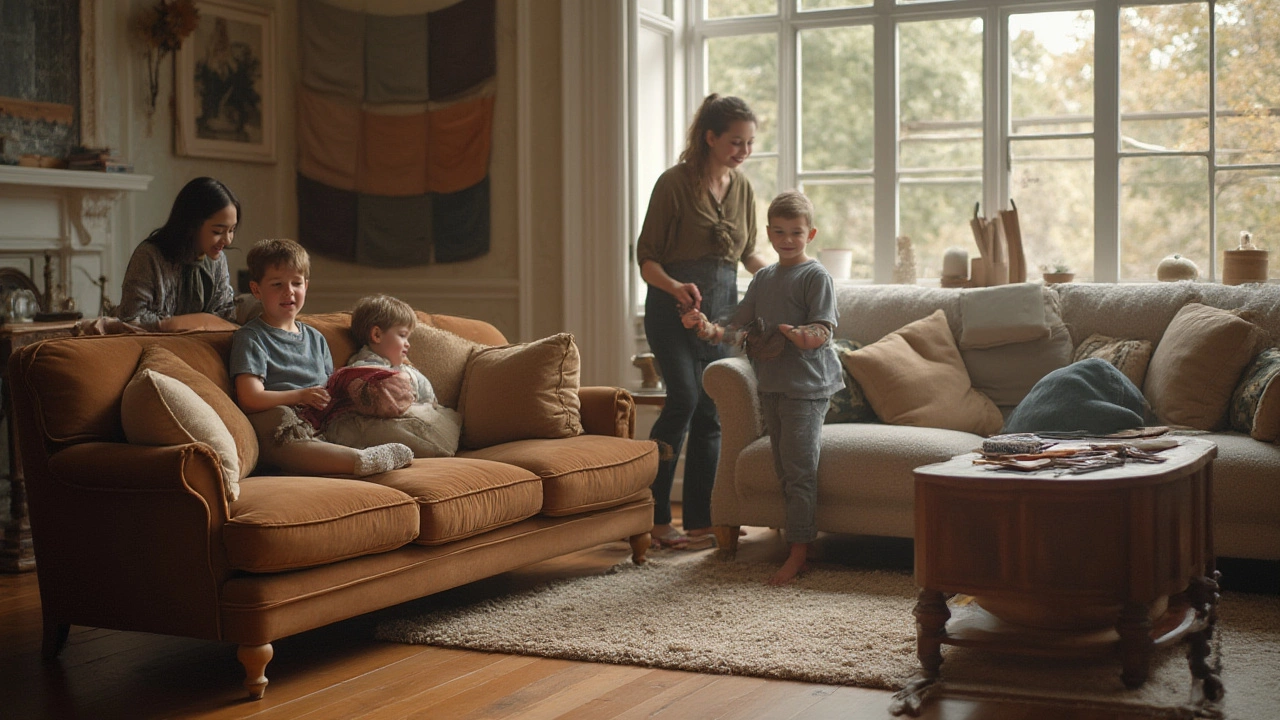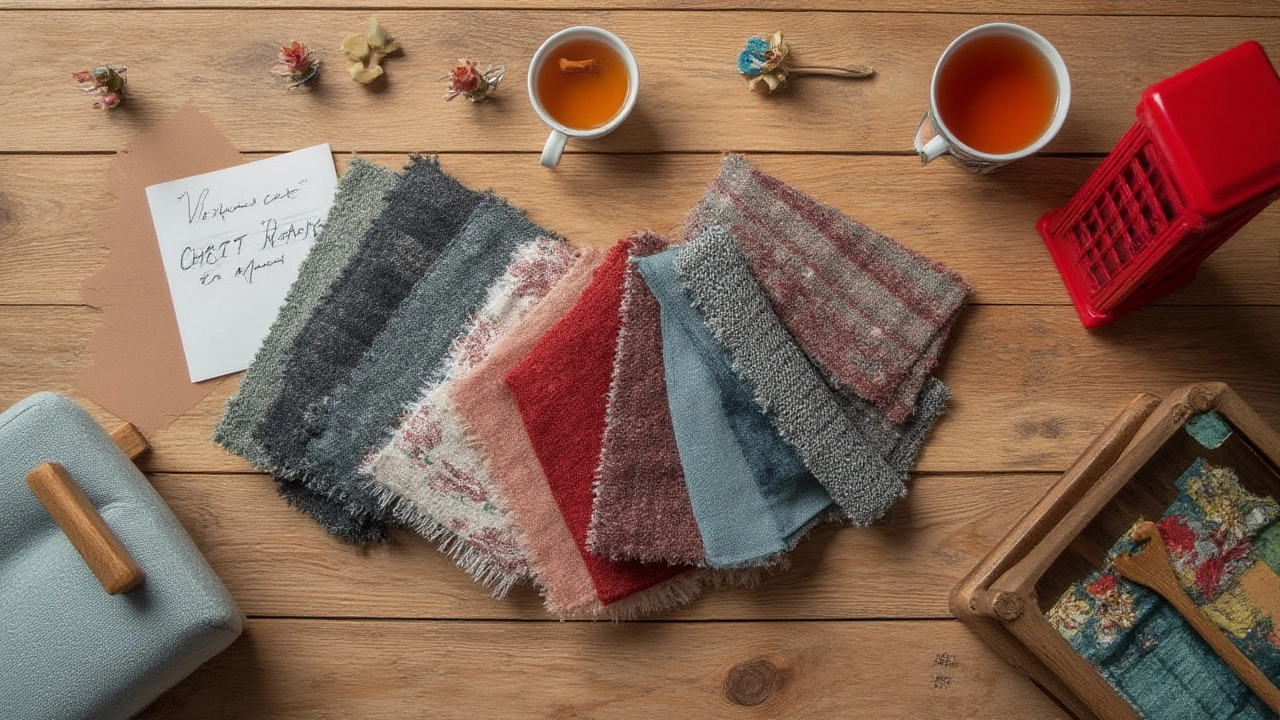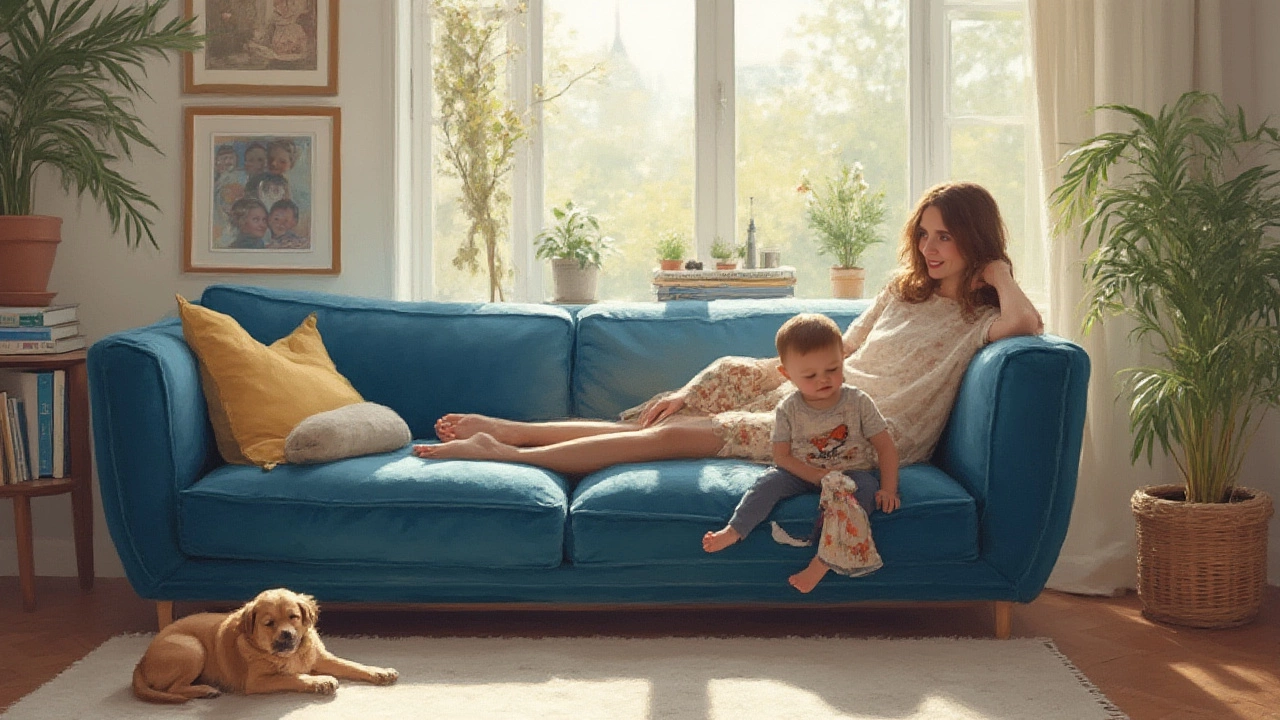Hardest Wearing Fabrics for Sofas: The Ultimate Guide for Durability
 Jul, 24 2025
Jul, 24 2025
The days of tiptoeing around the living room with a drink, worried you’ll start an accidental war with your partner about the mystery stain, feel like pure fiction to anyone with a truly tough sofa. The real game-changer isn’t a fancy warranty or a fabric spray; it’s the stuff your couch is actually made from. Think of the millions of battles your living room sofa faces. Kids springboarding for pillow fort glory. Charlie, my dog, making another ‘temporary’ bed in the corner. Takeout nights. Jump scares from coffee mugs. Sofas have to handle it all. So, what’s the hardest wearing fabric if you want your couch to thrive, not just survive?
What Makes a Sofa Fabric “Hard Wearing”?
First up: don’t get conned by beautiful but fragile fabrics. Silk’s got style, but let’s face it—the second you spill anything, or Charlie traipses across it with muddy paws, it’s game over. Durable sofa fabrics aren’t just about brute strength. Sure, they need to resist rips and tears, but they also have to shrug off stains, fading, and pet claws. Look for two things: the type of fiber and the weave. Tightly woven fabrics using strong fibers—usually synthetics like polyester, nylon, or acrylic—almost always outlast the natural stuff. There’s a reason your grandma’s wool-blend sofa still looks decent in the attic.
If you love a good stat (don’t we all?), manufacturers use something called a Martindale or double rub test to measure wear. It’s simple: the higher the number, the tougher the fabric. Anything above 15,000–20,000 double rubs is considered heavy-duty. Some commercial-grade fabrics clock in at 100,000 or more. That’s enough to handle just about anything short of a chainsaw. Here’s a quick look at how popular fabrics stack up:
| Fabric | Martindale / Rub Count | Notable Features |
|---|---|---|
| Microfiber | 30,000–100,000+ | Stain-resistant, pet-friendly, soft |
| Leather (Top Grain) | 100,000+ | Tough, easy to clean, ages well |
| Polyester Blends | 15,000–50,000+ | Colorfast, durable, affordable |
| Olefin (Polypropylene) | 20,000–50,000 | Moisture, stain, and fade-resistant |
| Linen | 8,000–15,000 | Cool, natural, less resistant to wear |
| Cotton | 10,000–15,000 | Soft, natural, not highly durable |
Microfiber deserves a shoutout. Made of super-fine polyester, it’s tightly woven so dirt and liquids just float on top, waiting to be wiped away. It’s almost a cheat code for busy houses or pet owners. Leather—especially the real top-grain kind—is the sofa world’s tank. Not scratch-proof (nobody’s perfect), but unless you’re raising a family of bobcats, it stands up to most of what life throws at it. Poly-blends and olefin also get rave reviews in durability, colorfastness, and price.
The weave style matters. Twill and canvas weave resist snagging and fraying, so you can dare to let your kids and pets lounge (almost) worry-free. Loose weaves? They pill, fade, and trap crumbs. I once had a chenille sofa that doubled as a crumb magnet. Never again.
Want a long-lasting sofa? Skip slipcovers (they’ll shift, they’ll wrinkle), and focus on getting the hardest wearing fabric built right into the upholstery. If the fabric label reads “performance” or “commercial grade,” that’s usually not just marketing talk—there’s real science behind those words.

Sofa Fabrics That Go the Distance (and Why They Work)
If you’ve got a full house, a couple of pets, or just a penchant for pizza nights, you know the pain of picking the wrong sofa fabric. Let’s break down the contenders that actually live up to the hype.
1. Microfiber (aka Microsuede): Microfiber is polyester’s overachieving cousin. The fibers are so tightly woven that even red wine has trouble making friends with them. Dust, dirt, and pet hair usually just brush off. I had a wine ‘incident’ last Christmas—one quick blot, and my couch looked untouched. Plus, unless you really try, it doesn’t snag or pill like wool. One family I know went from “Do not eat on the couch!” to serving spaghetti bolognese on movie night, all thanks to their indestructible microfiber.
2. Leather—But Not All Leather is Equal: If you want classic style and wear, go with top-grain leather. It costs more, sure. But there’s no fabric more forgiving or easier to wipe down. Avoid split leather or bonded ‘faux’ leather—they peel and crack faster than you can say “Couch Potato.” Real leather does scratch, but those little marks actually add character over time (unlike a big ugly rip in fake stuff). Families with allergies love leather, too, because it doesn’t trap dust mites or pet smells. For the germ-conscious, a quick wipe with a damp cloth or baby wipe beats a weekly deep clean.
3. Polyester and Polyester Blends: This synthetic has a reputation for being nearly bulletproof. Blends with cotton or viscose give you softness and a good stretch, but they still resist fading and fraying like a champ. Regular polyester also stands up to sunlight better than most naturals. If your living room gets a ton of sun, you want a sofa that won’t fade by Christmas. Many new performance fabrics marketed as ‘kid- or pet-friendly’ are basically polyester with extra treatments for repelling stains and liquids.
4. Olefin (Polypropylene): Not as famous, but if water-resistance is your top priority, this is your guy. It doesn’t absorb moisture, so mildew and mold aren’t an issue—a lifesaver if your sofa is near a window or in a basement. Olefin is kind of like a raincoat for your couch. It cleans up surprisingly well, too; simple soap and water will fix 99% of stains.
5. Velvet (Synthetic Only): Hear me out—velvet can be shockingly durable if it’s synthetic (think polyester, not cotton or silk). It delivers that plush, luxurious vibe while being surprisingly tough. Not ideal if you’ve got animals with claws (Charlie sure prefers more texture), but if you want a statement piece that’s not just beautiful but also practical, it’s worth a look.
Natural fibers like cotton and linen aren’t built for serious wear. Sure, they’re cool and soft, but after a while, the seat turns sad and saggy. Plus, stains are a nightmare. Wool, meanwhile, does pretty well and is naturally fire-resistant, but it’s pricey, can pill over time, and isn’t usually found in affordable sofas.
Don’t ignore color and patterns. Darker colors and pronounced patterns are way more forgiving than plain creams or light greys. My first apartment had a white sofa. After one round with Charlie, it looked like a mud wrestling ring. Lesson learned.

Maintenance, Myths, and Insider Tips for Tough Sofa Fabrics
Having a hard-wearing fabric helps, but a little bit of knowledge keeps your sofa out of trouble for years. The biggest trap? Assuming you can treat all tough fabrics like they’re indestructible. Even the best need a little TLC.
- Vacuum weekly. Even performance fabrics benefit from getting rid of crumbs, hair, and dust before it gets ground in. A simple upholstery brush does wonders.
- Spot clean the smart way. Those “miracle” cleaners promising to fix any stain usually make things worse. Plain old dish soap and water fixes 99% of problems on synthetics. With leather, stick to recommended creams and avoid soaking it. Never use bleach.
- Rotate the cushions. This combats sagging and fabric wear in one spot. If your cushions flip, flip them. If not, swap them around as best you can.
- Keep direct sunlight in check. Even the best sofa durability will suffer if it’s baking in front of a sunny window every day. If you can, pull the sofa away from harsh direct light or try sheer curtains.
- Cover the no-go zone. If you’re not above a throw blanket or stylish slipcover on the main crash zone, you’ll save your fabric a lot of heartache. My sofa’s arms have seen more protection than a Goalkeeper’s gloves.
- Treat stains immediately. The faster you blot (never rub!), the less likely your fabric will hold onto the memory. This is especially true for lighter shades of even the best fabrics.
- Beware of pet claws. Trimming nails and giving pets a blanket of their own helps, but if you’ve got a hyper puppy or sharp-clawed cat, microfibers and leather will handle playtime scars better than anything else.
- Read the tag. Those care instructions on the underside of your cushion? Follow them! Each fabric has its quirks, and one mistaken wash can turn your sturdy couch into a lumpy, faded disaster.
Here’s something else you might not expect: some commercial-grade performance fabrics now use recycled plastic bottles as a raw material. These not only stand up to high traffic but also let you brag about your eco-friendly home. A small but growing number of sofa makers are offering sustainability without sacrificing toughness, so if you want the feel-good factor, keep an eye out for those recycled claims.
Don’t get sucked in by the myth that more expensive always means longer lasting. Sometimes a cheaper poly-blend outlasts a fancy linen or wool set. Check those Martindale or ‘double rub’ scores. If a manufacturer can show 25,000 or more on a test, that’s a solid bet for family living rooms, busy dens, or mountain cabins alike.
Try before you buy! If you’re shopping in-person, ask for a sample swatch and play out the scenarios. Rub it, try scratching a corner, spill a little water, or see how easily pet hair lifts off. Some stores will even let you take a swatch home and run real-life tests. It’s a small step that can save you a big headache later on.
One last pro tip: If odor is an issue—say, your family includes a dog like Charlie—synthetics with minimal texture are usually easier to keep smelling fresh than any heavy weave or tufted design. Periodic airing out and a sprinkle of baking soda before vacuuming can keep things pleasant between deep cleans.
So, if you want peace of mind and a sofa that won’t embarrass you the next time friends pop over, tough fabrics make all the difference. Microfiber and leather win the durability race, but as long as you check the stats, read the label, and give a little extra love when needed, you’ll get years of battle-hardened comfort. And hey, if you want a true durability test, invite a couple of kids and Charlie over for movie night. If your sofa survives that, you picked the right fabric.